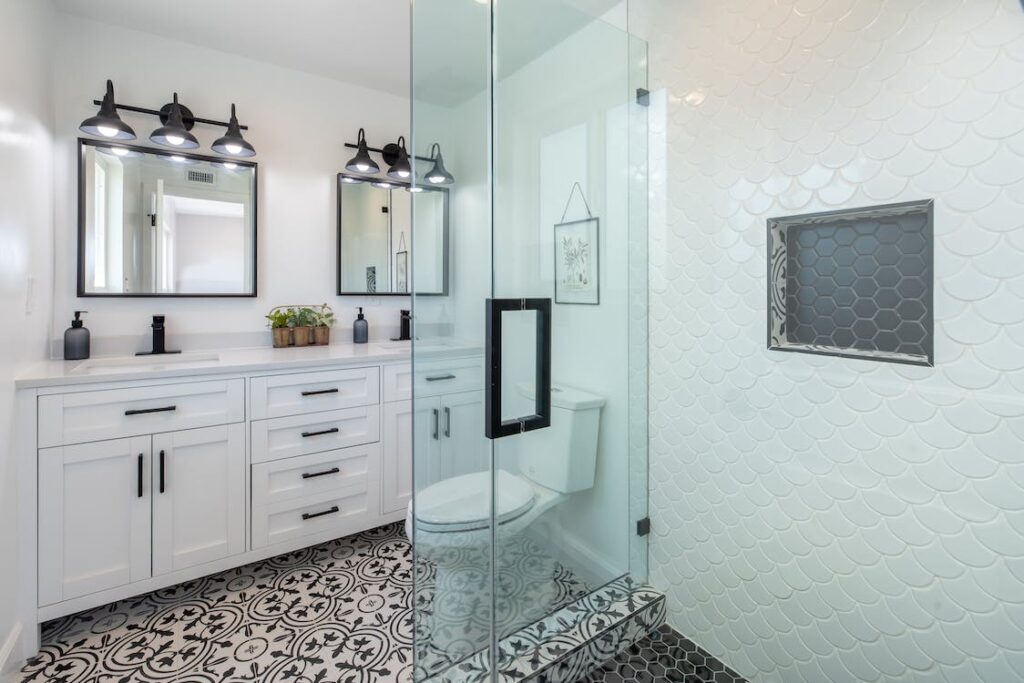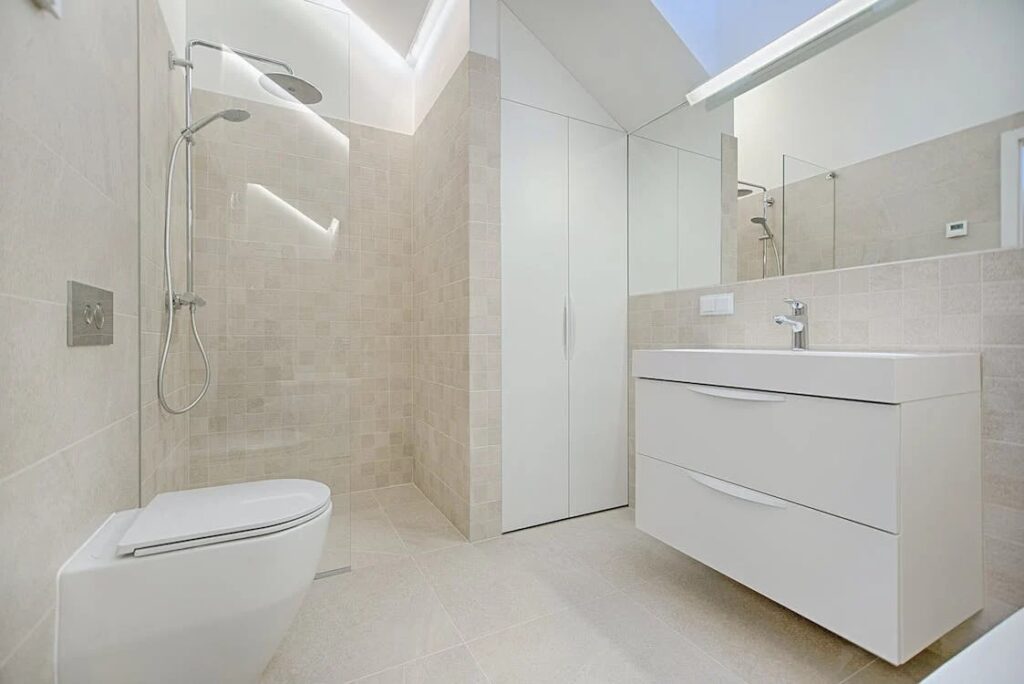- Free Estimates

Are you tired of taking a bath in a cramped, outdated bathtub? A walk-in shower can be a game-changer for your bathroom, offering a more spacious and modern bathing experience. However, converting a bathtub to a walk-in shower can seem overwhelming. Don’t worry – this ultimate guide from the best bathroom remodeler in Charlotte, NC, will take you through planning, preparation, and installation so that you can create the walk-in shower of your dreams.
Before diving into any remodeling project, planning and preparing is essential. This step will save you time, money, and frustration in the long run. Here are some things to consider before you start the conversion process:
The first step in converting a bathtub to a walk-in shower is measuring the bathtub area. This will help you determine the size and shape of your new shower. Remember that the new shower should be big enough to fit you and your toiletries comfortably. If you’re unsure about the size, consult a bathroom remodeler in Charlotte, NC.
After you have measured the bathtub area, you can start choosing the materials and fixtures for your new shower. The most popular options for shower walls are tiles and acrylic panels. Tiles offer more customization options, while acrylic panels are more cost-effective. You can choose between tiles, acrylic, or a pre-made shower pan for the shower floor. Fixtures such as showerheads, controls, and shelves can also be chosen based on your preferences.
It’s essential to make a budget and timeline for your project. This will help you avoid overspending and ensure that the project is completed on time. Consider factors such as materials, labor, and unexpected expenses. If you’re unsure how to make a budget, consult a bathroom remodeler in Charlotte, NC.
Before you start the conversion process, ensure you have all the necessary tools and supplies. These may include a reciprocating saw, hammers, screwdrivers, drill, level, tile cutter, and safety gear such as goggles and gloves. Suppose you don’t have access to the necessary tools and supplies. In that case, hiring a professional bathroom remodeler in Charlotte, NC, is best.
Now that you’ve done the prep work, it’s time to remove the old bathtub. Here are the steps to follow:
The first step in removing the bathtub is turning off the water supply and disconnecting the plumbing. This will prevent water damage and ensure the plumbing is ready for the new shower.
After you have disconnected the plumbing, remove the tub surround or tile. This can be done with a reciprocating saw, hammer, and chisel. Again, make sure to wear safety gear such as goggles and gloves.

After removing the tub surround or tile, you can cut and remove the tub itself. This can be done with a reciprocating saw or hammer. Make sure to dispose of the tub properly.
After removing the tub, you may notice holes or damage to the walls or flooring. Patch these up with drywall or concrete, depending on the surface.
After removing the bathtub, installing the new walk-in shower is time. Here are the steps to follow:
The first step in installing the new shower is to install a shower pan or base. This will prevent water from leaking onto the bathroom floor. You can choose from a pre-made pan or a custom-made pan.
After installing the shower pan, you can start building the walls and installing waterproofing materials. First, use cement board or waterproof drywall for the walls. Next, apply a waterproof membrane or coating to prevent water from seeping through.
Next, install the shower fixtures, such as the showerhead, controls, and shelves. Follow the manufacturer’s instructions and use the right tools and materials.
Finally, add the finishing touches to your new shower. This may include shelves, benches, or other features that will make your shower more functional and comfortable.
Tiling your new walk-in shower is essential in creating a modern and stylish bathroom. Here’s what you need to know:
The first step in tiling your shower is choosing suitable tiles. You can choose from various materials, such as ceramic, porcelain, or natural stone. Consider factors such as durability, slip resistance, and style.
After choosing the tiles, you must measure and cut them to fit the shower walls and floor. Then, use a tile cutter or wet saw to cut the tiles to the correct size and shape.
Now it’s time to install the tiles. First, apply suitable adhesive to the walls and floor, and use spacers to ensure even spacing between the tiles. After the adhesive dries, apply the grout to fill in the gaps.
Finally, seal the grout to prevent water damage and staining. Use a grout sealer and follow the manufacturer’s instructions.

If you or someone in your household has mobility issues, it’s essential to install accessibility features in your new walk-in shower. Here are some options to consider:
Install grab bars or handrails in the shower to support and prevent falls. These can be installed on the walls or attached to the shower fixtures.
Adding a bench or seat to the shower can make it more comfortable and accessible. Choose a bench or seat that is sturdy and waterproof.
Consider choosing a showerhead with adjustable height or other features such as handheld or massaging jets. This will make the shower more comfortable and functional for people with different needs.
Keeping your new walk-in shower clean and well-maintained is vital for its longevity and your health. Here are some tips:
Clean the shower regularly with a mild detergent or vinegar and water solution. Use a squeegee to remove excess water after each use.
Prevent mold and mildew by keeping the shower well-ventilated and using a fan or dehumidifier. Avoid harsh chemicals or bleach, which can damage the tiles and grout.
If you’re uncomfortable with the DIY approach or want a more professional-looking finish, consider hiring a bathroom remodeler in Charlotte, NC. Here’s what to look for:
A professional remodeler can offer expertise, experience, and access to high-quality materials and fixtures. They can also save you time and stress by handling the project from start to finish.
Ask for referrals from friends, family, or online review sites. Look for contractors who are licensed, insured, and experienced in bathroom remodeling. Ask about their experience, timeline, and pricing. Ensure they know their policies for change orders, warranties, and communication.
Converting a bathtub into a walk-in shower can be a rewarding and transformative project for your bathroom. Planning, preparation, and installation allow you to create a more spacious, modern, and accessible shower that meets your needs and style. So whether you choose the DIY approach or hire a professional bathroom remodeler in Charlotte, NC, follow the steps and tips in this guide to ensure a successful and stress-free project.
For more information and a free consultation, Contact Shower Remodel Experts Charlotte today!
4425 Sharon Rd Suite 405, Charlotte, NC
28211, United States
Copyright © 2023 Shower Remodel Experts Charlotte